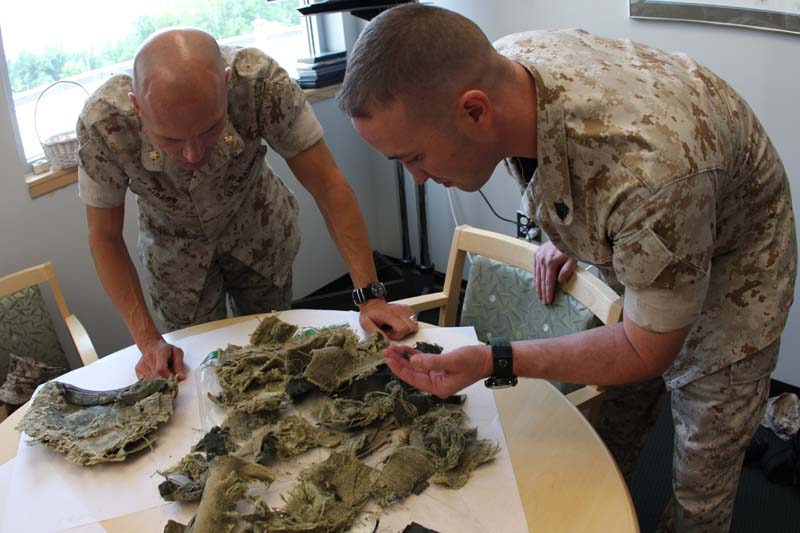 Drexel University engineers will soon be working alongside scientists from the Army Research Lab to refine a new way of detecting the invisible damage in aircraft structures that could lead to catastrophic failure. The institutions recently signed a collaborative research agreement that will formally connect the ARL’s Vehicle Technology Directorate with Drexel mechanical engineers at the forefront of advanced, non-destructive structural testing.
Drexel University engineers will soon be working alongside scientists from the Army Research Lab to refine a new way of detecting the invisible damage in aircraft structures that could lead to catastrophic failure. The institutions recently signed a collaborative research agreement that will formally connect the ARL’s Vehicle Technology Directorate with Drexel mechanical engineers at the forefront of advanced, non-destructive structural testing.
“This opportunity to collaborate in a formal partnership provides Drexel’s faculty and students from numerous disciplines, with the ability to conduct collaborative, fundamental and applied research with experts from the Army Research Laboratory,” said Aleister Saunders, PhD, senior vice provost for research.
Under the Cooperative Research and Development Agreement, Drexel will become an “open campus,” which means researchers from across the university will have access to ARL scientists and research facilities. And, in return, ARL scientists will have the opportunity to come on campus and work with Drexel researchers. The partnership with Drexel is one of about 180 formal research agreements that the federal government has with non-government and university partners. The bulk of Drexel’s work with ARL will take place at Adelphi Laboratory Center and Aberdeen Proving Ground in Maryland.
“ARL’s Open Campus business model creates a dynamic, cooperative science and technology ecosystem that links government assets with the global research community,” said Thomas Mulkern, chief of the ARL Technology Transfer Office. “Collaboration is centered on mutual scientific interest and investment by all partners.”
The ARL’s Vehicle Technology Directorate — the branch of the lab dedicated to the “ pursuit of mobility-related science and technologies leading to advanced capabilities and improved reliability for Army air and ground vehicles” — is constantly improving the way it detects material faults or damage that could lead to major vehicle failures.
One of the first collaborative research endeavors will be with Antonios Kontsos, PhD, a professor in the College of Engineering, who heads the Theoretical & Applied Mechanics Group. Kontsos’s lab has pioneered new methods for using sound and light to study structural integrity and quantify fatigue and fracture damage without affecting the structure itself.
“Our nondestructive testing methods can play an integral role in the Army’s vehicle structural health monitoring system,” Kontsos said. “Using procedures such as acoustic emission testing, acousto-ultrasonics, digital image correlation and infrared thermography, we can glean information that will allow us to infer the current operational state and remaining life of key structures in Army vehicles. We want to be able to not only predict failure but come up with an individualized plan for monitoring and preventing it for each vehicle in service.”
Kontsos’s group has applied its technology to inspect buildings, bridges and other infrastructure in affected areas of New Jersey in the aftermath of Hurricane Sandy. Deploying the sensing equipment via drones and other aircraft allowed the team to examine large structures without further damaging them or putting themselves in harm’s way. This strategy could lend itself to equipment monitoring in the battlefield, according to Kontsos.
“I could see our work being folded into technology such as unmanned aerial vehicles that can collect data and monitor the structural health of vehicles while they’re in action,” Kontsos said. “Our methods will also contribute to the development of zero-maintenance and smart equipment technology that can assess and repair its own damage or take itself out of commission if it is irreparable.”
Under the agreement research from across the University will have the opportunity to contribute to ARL’s research thrusts. It will also create a pipeline for students to work directly with the Laboratory in funded research and co-op positions.
“The agreement instantly expands our research capabilities and provides a defined administrative framework for our involvement in mission-oriented research and development,” Saunders said. “The partnership also creates new experiential learning opportunities for students and connects them to career pathways within the Department of Defense.”
A ceremony to formally announce the partnership will be held in June. Information sessions will take place at Drexel over the next several months to help connect the research community with the opportunities provided by this partnership. Interested researchers can also email ARL.CRADA@drexel.edu to learn more.